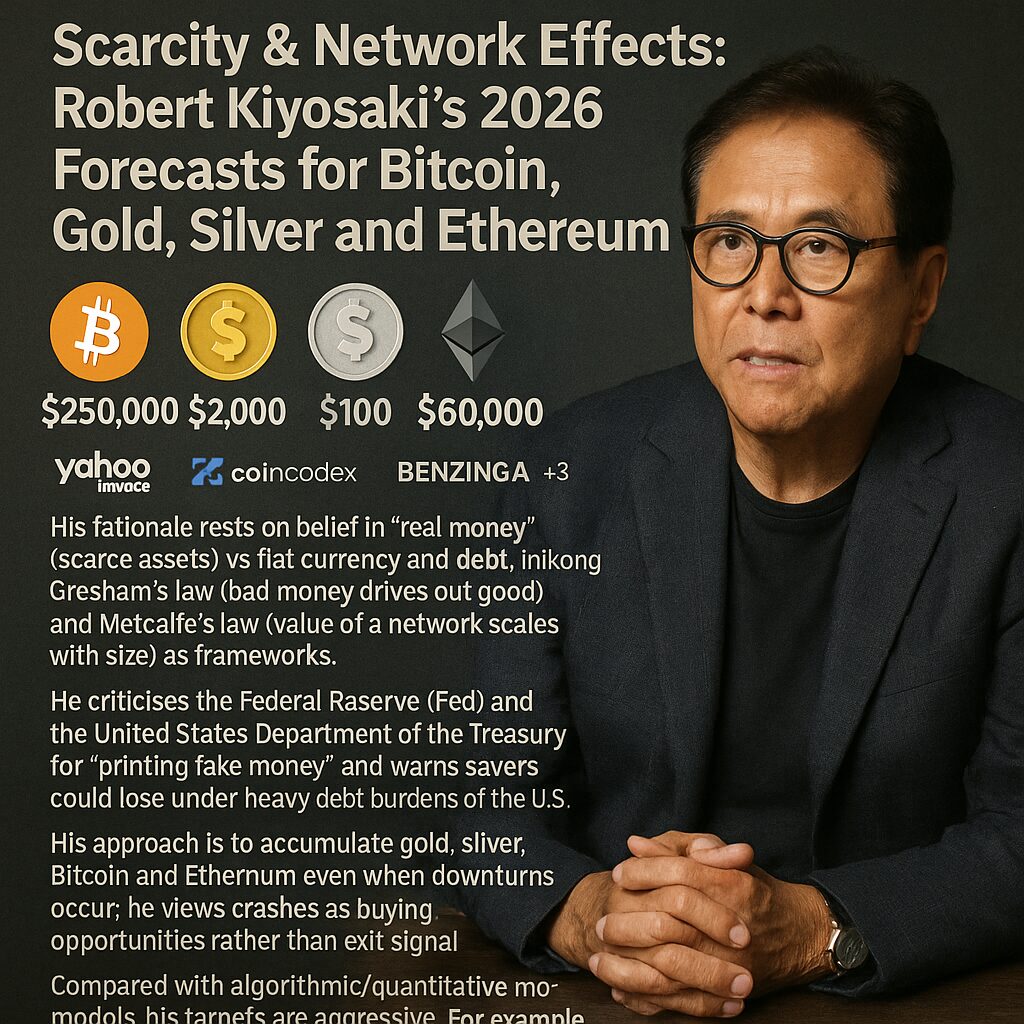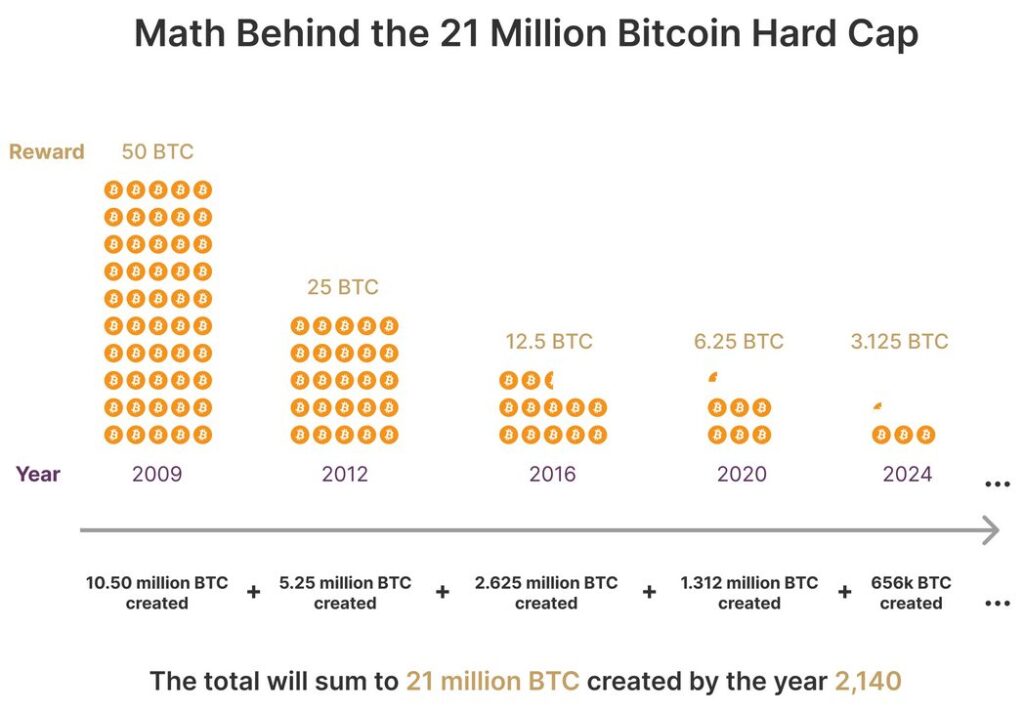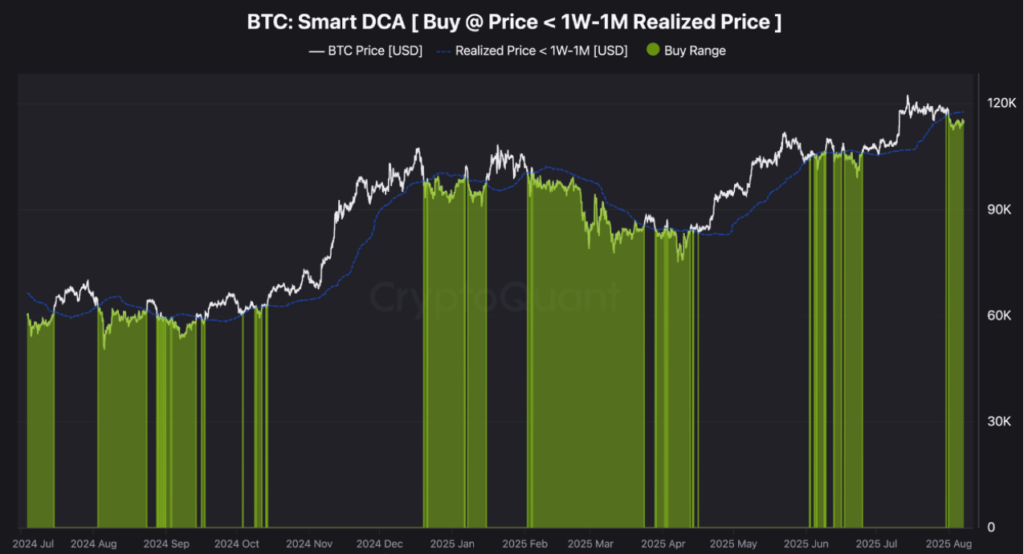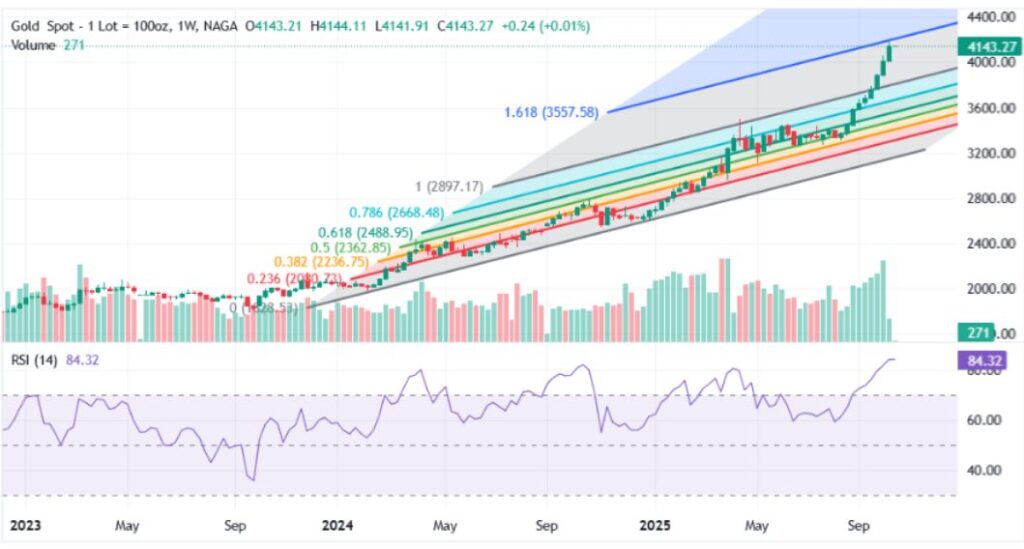
Main Points :
- Robert Kiyosaki projects: Bitcoin (BTC) → US $250,000, gold → US $27,000, silver → US $100, Ethereum (ETH) → US $60,000 by ~2026.
- His rationale rests on belief in “real money” (scarce assets) vs fiat currency and debt, invoking Gresham’s law (bad money drives out good) and Metcalfe’s law (value of a network scales with size) as frameworks.
- He criticises the Federal Reserve (Fed) and the United States Department of the Treasury for “printing fake money” and warns savers could lose under heavy debt burdens of the U.S.
- His approach is to accumulate gold, silver, Bitcoin and Ethereum even when downturns occur; he views crashes as buying opportunities rather than exit signals.
- Compared with algorithmic/quantitative models, his targets are aggressive. For example, one model (CoinCodex) suggests BTC ~$275k by 2028, ETH ~$9.5k by 2028, gold far below his $27k target by 2026.
1. Kiyosaki’s Price Predictions and Asset Mix

Robert Kiyosaki, the bestselling author of Rich Dad Poor Dad, recently announced on X (formerly Twitter) that his targets for 2026 include: Bitcoin at US$250,000; gold at US$27,000 per ounce; silver at US$100 per ounce; and Ethereum at US$60,000.
He explained that his gold target (US$27k) was derived from his friend Jim Rickards, a known macro analyst and gold advocate. He also disclosed that he personally owns two gold mines and has been buying gold since 1971, when President Nixon ended the gold-dollar convertibility.
Regarding Ethereum, he referenced another analyst, Tom Lee, to support his bullish ETH view.
Importantly for new-asset-seekers and yield-seeking crypto practitioners, Kiyosaki emphasises that his holdings span real assets (gold, silver) and blockchain-native value (Bitcoin, Ethereum) — fitting into your interest zone: emerging crypto, income opportunities, blockchain practical usage.
2. Underlying Theoretical Framework – Scarcity & Network Value

Kiyosaki frames his investment logic around two “laws of money”: Gresham’s Law and Metcalfe’s Law.
- Gresham’s Law: typically expressed as “bad money drives out good” when both forms are legal tender. Kiyosaki adapts this: fiat currency is “fake money” because its supply can be arbitrarily expanded; scarce assets (gold, silver, Bitcoin) are “real money” because supply is constrained or non-printable.
- Metcalfe’s Law: originally a network-theory principle that the value of a network scales roughly with the square of its number of users. Kiyosaki applies this to Ethereum (and Ethereum-layer use cases) on the basis that as more stablecoins and value flows migrate onto ETH (or EVM-compatible chains), network value rises dramatically.
He thus argues: Bitcoin is digital gold (scarce, independent of fiat), Ethereum is the main “financial network” for stablecoins and other blockchain activity, and both will benefit from structural flows away from fiat.
3. Macro Environment: Debt, Fiat, and Wealth Preservation

Kiyosaki repeatedly highlights that the United States has become “the biggest debtor nation in history” and warns that savers (holding fiat cash) are losers, because the money they hold is being devalued by debt-financed currency issuance.
According to his logic:
- Central banks and treasuries are printing (or creating) money to service debt or finance deficits, undermining the value of fiat.
- Hard assets with limited supply cannot be printed and thus become safe-haven stores of value.
- An environment of rising debt, inflation risk and currency uncertainty creates a structural tailwind for assets like gold, silver, Bitcoin, and other scarce crypto networks.
For practitioners exploring new crypto assets and income opportunities, this macro narrative underscores the rationale for holding not just large-cap crypto (BTC, ETH) but also scarce-supply, network-oriented tokens and leveraging blockchain use cases where fiat weakness strengthens value propositions.
4. Strategy: Buy on Fear, Stand Firm Through Volatility

Kiyosaki’s investment strategy emphasises accumulating — not selling — even when markets are under pressure:
“Crash coming: Why I am buying not selling.”
He uses downturns as opportune entry points rather than triggers to exit. He states that real wealth is built during periods of fear, and that he continues to acquire gold, silver, Bitcoin and Ethereum.
For blockchain-practical use and yield-seeking audience: the message is consistent with “accumulate scarce assets early, stand through cycles, leverage network growth.” In the realm of crypto and token issuance (for example your work on non-custodial wallets, swaps, token issuance), this viewpoint suggests building products around scarcity (token caps), network effect (user growth), and long-term hold rather than short-term flip.
5. Comparison with Quantitative/Model Forecasts & Considerations

While Kiyosaki makes bold calls, algorithmic and quantitative models yield different numbers for the same assets. For example, according to one model (CoinCodex):
- Bitcoin ~ US$275,000 by 2028 (vs Kiyosaki’s US$250k by 2026)
- Ethereum ~ US$9,500 by 2028 (vs Kiyosaki’s US$60,000)
- Gold and silver projections were far more conservative than Kiyosaki’s US$27k and US$100 respectively.
These comparisons highlight: - Kiyosaki’s targets are aggressive, imply a high-risk/high-reward scenario.
- Quant models tend to be more conservative and factor historical volatility, adoption curves, etc.
For your audience (seeking new crypto assets and practical blockchain applications): it means that while you can draw insight from macro-narratives (Kiyosaki) and structural frameworks (scarcity, networks), you should also overlay data-driven modelling (adoption curves, on-chain metrics, tokenomics) and risk-management.
6. Practical Implications for New Crypto Assets, Income Streams and Blockchain Applications
For readers hunting new crypto assets, exploring income models, and developing blockchain-use cases, here are the actionable takeaways:
- Scarcity matters: Tokens with capped supply, meaningful token burn or locked issuance have structural appeal in a world wary of inflation and fiat dilution.
- Network effect counts: Platforms with growing active users, developer ecosystems, high TVL (total value locked), or stablecoin flows (as Kiyosaki argues for ETH) may deliver outsized value growth.
- Hedge mindset: Positioning part of a portfolio toward non-correlated assets (digital gold, crypto networks) can act as a hedge against macro-fiat weakness—this mindset influences token design, wallet strategy, swap infrastructure: e.g., designing your wallet to support scarce-token flows, staking, yield across networks.
- Long game: Bounce-trading is less aligned with Kiyosaki’s view; instead accumulation and holding through cycles is emphasised. For your work designing swap UX (BTC ↔ ETH) in your dzilla Wallet project, this suggests building for user-stickiness, long-term holding, simplicity and transparency rather than short-term speculative churn.
- Token issuance & marketing: When you evaluate no-code platforms (PinkSale, GemPad, etc) for an ICO/presale, narratives around scarcity, network utility, real-world value, and inflation hedge can differentiate your offering. Embedding that narrative in your white-paper (“Two-Extremes Model”: Asset-Backed Representation vs Autonomous Trust Tender) aligns well with this macro context.
- Risk-management: High upside forecasts (like $250k Bitcoin) come with high volatility risk. Be prepared for drawdowns, regulatory shocks, token-unlock schedules, tech-risk. Designing your wallet with clear user disclosure, transparent UX, and guardrails (e.g., how many tokens unlocked, vesting, swap slippage) helps convert narrative appeal into robust product.
Conclusion
Robert Kiyosaki’s recent projections—Bitcoin at US$250,000, gold US$27,000, silver US$100, Ethereum US$60,000 by 2026—rest on a worldview of fiat currency weakness, debt overhang and structural shift toward scarce assets and powerful networks. His application of Gresham’s Law (fiat as “fake money”) and Metcalfe’s Law (network value growing with user base) provides a conceptual framework for vivid forecasts. While quantitative models are more conservative, the narrative is clear: for crypto investors and blockchain practitioners, the combination of scarcity, network growth and inflation hedge is a potent mix.
For those in your target audience—seeking new crypto assets, income sources, and practical blockchain implementation—this means building systems, wallets, tokens and infrastructures that reflect scarcity, network utility, long-term hold behaviour and transparent UX. At the same time, prudence is required: bold upside comes with risk. As you design projects (such as your dzilla Wallet or ICO launch), aligning product design with these macro narratives while embedding token-economics, clear user educations, and robust guardrails will differentiate your strategy.

